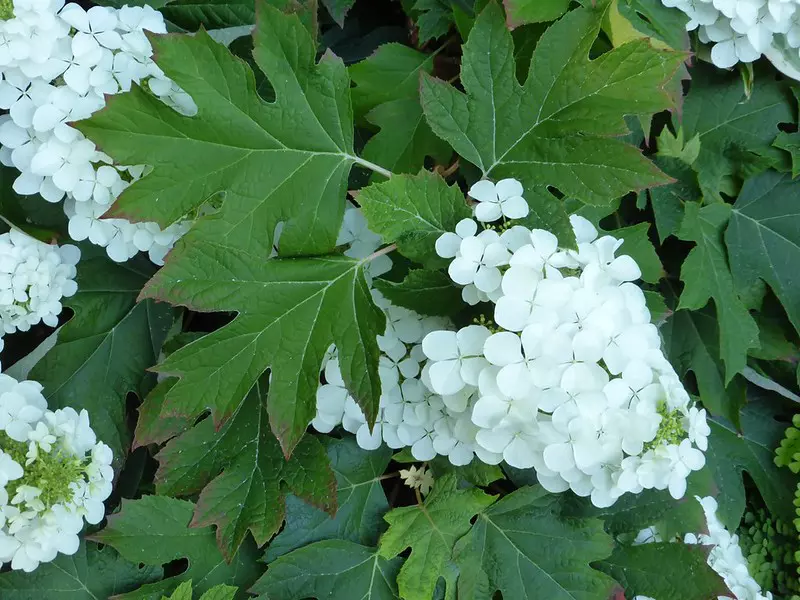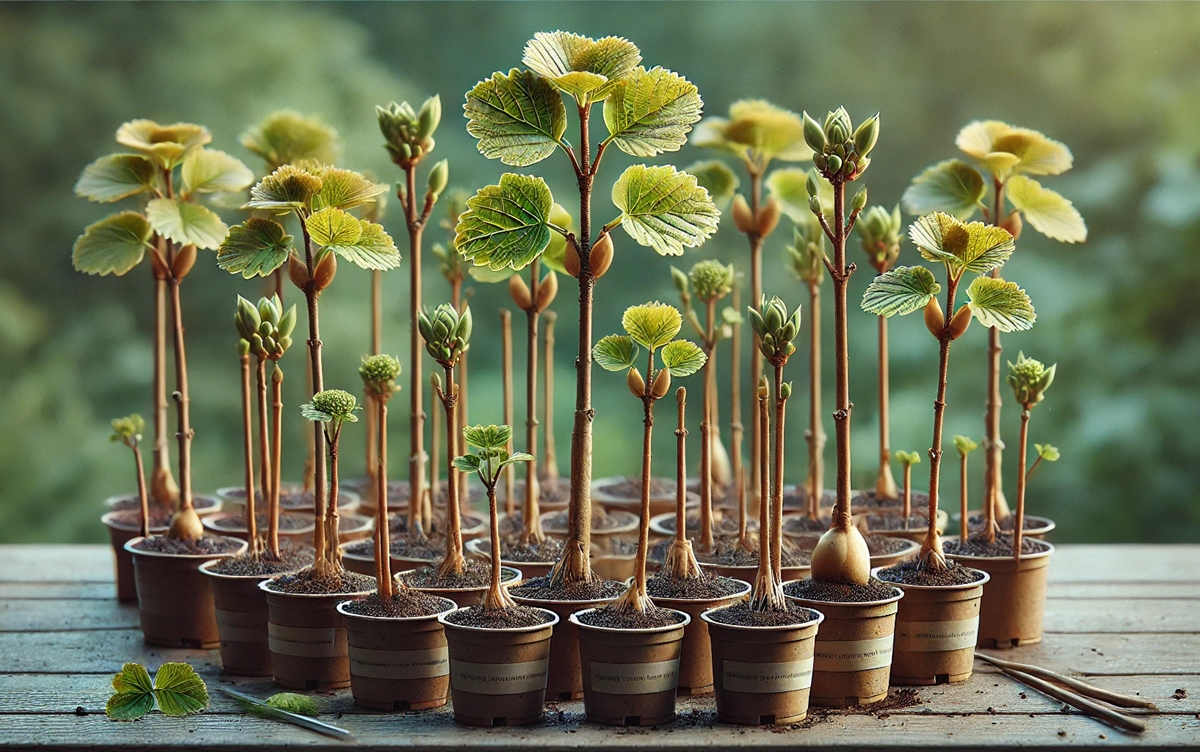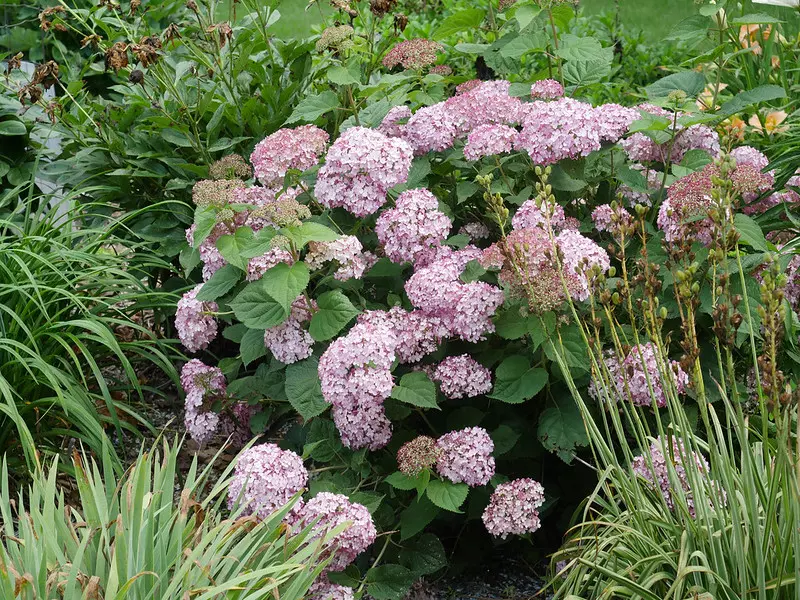Table of Contents
The oakleaf hydrangea (Hydrangea quercifolia) is a stunning deciduous shrub known for its
large, oak-shaped leaves and beautiful, cone-shaped flower clusters. Native to the southeastern United States,
it thrives in partial shade and offers year-round interest with its vibrant autumn foliage and peeling bark in winter.
Selecting the right companion plants for oakleaf hydrangeas enhances the garden’s visual appeal and promotes plant health.
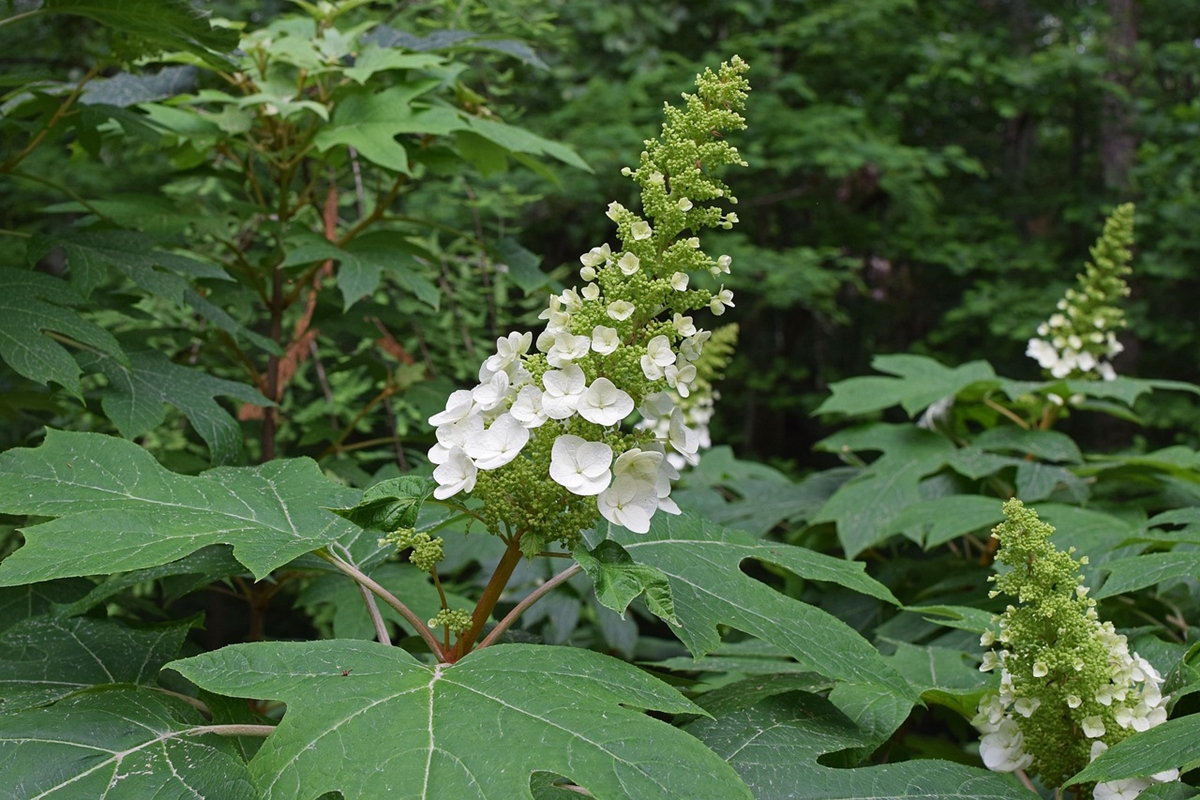 Large oakleaf hydrangea (Hydrangea quercifolia) with its companion plants. - Source: pixabay.com; Author: Jan Haerer / leoleobobeo; License: Pixabay Content License
Large oakleaf hydrangea (Hydrangea quercifolia) with its companion plants. - Source: pixabay.com; Author: Jan Haerer / leoleobobeo; License: Pixabay Content License
Why Companion Planting Matters
Companion planting is a gardening practice that involves growing different plant species in close proximity to benefit each other. For oakleaf hydrangeas (Hydrangea quercifolia), selecting the right companion plants can significantly improve their growth, overall health, and the aesthetic value of your garden. This approach is rooted in centuries of traditional gardening techniques and is supported by modern horticultural research in the UK, USA, and Australia.
While oakleaf hydrangeas are prized for their large, lobed leaves and stunning cone-shaped flowers, their full potential is best realised when planted alongside compatible species. Companion planting is not only about visual appeal; it encompasses ecological benefits, soil health improvements, and pest management, making it a holistic approach to gardening.
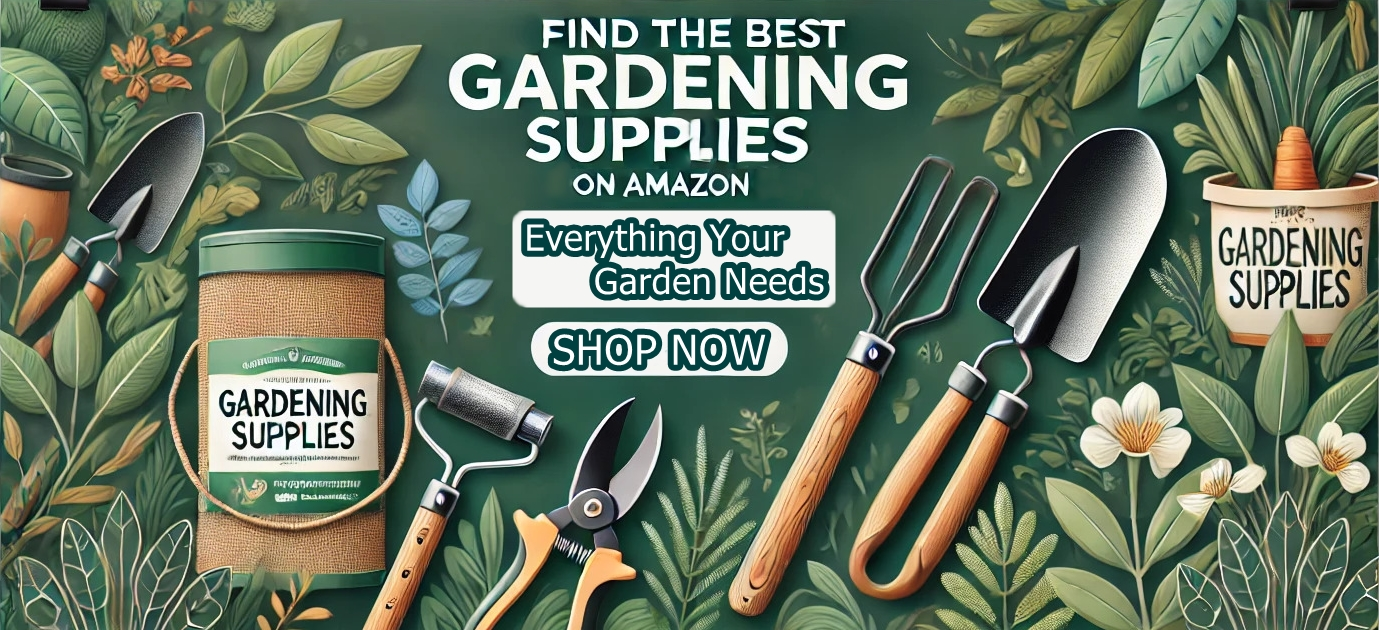
1. Enhancing Plant Health and Growth
One of the main reasons companion planting matters is its ability to promote healthier growth for oakleaf hydrangeas. Certain plants can improve soil structure, increase nutrient availability, and provide necessary shade or wind protection. For instance, ground covers like creeping thyme help retain soil moisture and prevent erosion, essential for hydrangeas that thrive in consistently moist but well-drained soil.
- Nitrogen-fixing plants: Some companion plants, such as clover, enrich the soil by adding nitrogen, an essential nutrient that supports leafy growth.
- Soil conditioning: Deep-rooted plants like comfrey can draw up nutrients from deeper layers, making them accessible to shallow-rooted plants like hydrangeas.
- Moisture retention: Low-growing companions act as living mulch, reducing the need for frequent watering.
2. Natural Pest and Disease Management
Oakleaf hydrangeas are generally resilient but can still be susceptible to pests like aphids and spider mites. Companion planting can play a crucial role in pest control by attracting beneficial insects or repelling harmful ones without resorting to chemical treatments.
- Pest deterrents: Aromatic plants like lavender and rosemary can repel common pests, creating a natural protective barrier.
- Attracting beneficial insects: Flowers such as yarrow and dill attract ladybirds and lacewings, which prey on aphids and other pests.
- Disease prevention: Good plant spacing and the inclusion of air-circulating companions like ferns reduce humidity levels around hydrangeas, lowering the risk of fungal infections.
3. Improving Soil Quality and Nutrient Cycling
Healthy soil is fundamental for the success of any plant, and companion planting contributes to a more balanced soil ecosystem. Plants with varying root depths can optimise nutrient uptake and prevent soil depletion. For oakleaf hydrangeas, companions that improve soil aeration and prevent compaction are particularly beneficial.
- Deep-rooted plants: Help break up heavy soils, improving drainage for hydrangeas.
- Organic matter addition: Leaf-dropping companions like deciduous shrubs enrich the soil with organic matter as they decompose.
- Microbial diversity: Diverse plantings encourage a variety of soil microbes, essential for nutrient cycling.
4. Maximising Aesthetic Appeal and Seasonal Interest
Beyond practical benefits, companion planting enhances the visual dynamics of a garden. Oakleaf hydrangeas offer seasonal interest with their summer blooms and autumn foliage, and selecting companions that complement these features can create year-round beauty.
- Foliage contrast: Pairing hydrangeas with plants like heucheras provides colour and texture contrasts.
- Sequential blooming: Spring bulbs and autumn-flowering perennials ensure continuous garden interest.
- Height variation: Combining low-growing ground covers with taller perennials creates layered planting schemes.
5. Promoting Biodiversity and Ecosystem Health
Companion planting is a sustainable gardening strategy that supports local ecosystems. By planting a variety of species, you create habitats for pollinators, birds, and beneficial insects. This not only enhances the environmental value of your garden but also promotes resilient plant communities that can better withstand environmental stressors.
- Pollinator support: Flowers that attract bees and butterflies aid in pollination, indirectly benefiting hydrangea blooms.
- Bird attraction: Berry-producing companions can attract birds that help control pest populations.
- Balanced ecosystems: A diverse garden is less prone to pest outbreaks and nutrient imbalances.
6. Climate Adaptation and Microclimate Creation
In regions with extreme weather conditions, including parts of the UK, USA, and Australia, companion planting can help create favourable microclimates. By strategically placing certain plants around oakleaf hydrangeas, you can buffer them against harsh winds, excessive sun, or fluctuating temperatures.
- Windbreaks: Tall, sturdy plants can shield hydrangeas from strong winds, preventing leaf damage.
- Shade creation: Overhead companions can reduce sun stress during hot summer months.
- Temperature regulation: Dense planting helps maintain stable soil temperatures, supporting root health.
In summary, companion planting is more than just placing plants side by side-it is a thoughtful approach that integrates plant biology, soil science, and ecological principles to foster healthier, more resilient gardens. For those cultivating oakleaf hydrangeas, carefully chosen companions not only enhance visual appeal but also contribute to long-term plant vitality and ecosystem balance.
Best Companion Plants for Oakleaf Hydrangea
Choosing the best companion plants for oakleaf hydrangea (Hydrangea quercifolia) can significantly enhance the visual appeal, health, and longevity of your garden. Oakleaf hydrangeas thrive in partially shaded environments with well-drained, slightly acidic soil. The ideal companions not only share similar growing conditions but also complement the hydrangea’s seasonal features, such as its large, lobed leaves, cone-shaped flower clusters, and vibrant autumn foliage.
The right companion plants can provide essential benefits including improved soil moisture retention, natural pest control, extended blooming periods, and added texture and colour throughout the year. Below is a detailed guide to the top plant pairings that work beautifully with oakleaf hydrangeas in gardens across the UK, USA, and Australia.
1. Ferns: Adding Texture and Softness
Ferns are one of the most popular companion choices for oakleaf hydrangeas. Their delicate, feathery fronds contrast beautifully with the bold foliage of the hydrangea, creating a balanced visual effect. Both plants thrive in similar shady to partially shaded conditions with consistently moist soil.
- Benefits: Ferns help retain soil moisture, suppress weeds, and improve humidity levels around hydrangeas.
- Recommended varieties: Japanese painted fern (Athyrium niponicum), Lady fern (Athyrium filix-femina), and Christmas fern (Polystichum acrostichoides).
- Growing tip: Plant ferns around the base of the hydrangea to cover bare soil and enhance the garden’s lushness.
2. Hostas: Foliage Contrast and Ground Coverage
Hostas are renowned for their broad, variegated leaves, which provide an excellent contrast to the oakleaf hydrangea’s textured foliage. Both plants prefer similar growing environments, making them ideal companions. Hostas also serve as effective ground covers, helping to maintain soil moisture and reduce weed growth.
- Benefits: Their dense foliage shades the soil, reduces evaporation, and prevents weed competition.
- Recommended varieties: ‘Sum and Substance’ for large, lime-green leaves; ‘Patriot’ for white-edged foliage; and ‘Blue Angel’ for bluish-green hues.
- Growing tip: Plant hostas in clusters around the hydrangea for maximum visual impact and functional ground coverage.
3. Heucheras (Coral Bells): Year-Round Colour and Texture
Heucheras, also known as coral bells, are prized for their colourful foliage, ranging from deep purples to vibrant oranges and lime greens. Their low-growing habit and shade tolerance make them perfect underplantings for oakleaf hydrangeas. Heucheras add a splash of year-round colour beneath the hydrangea canopy, even when the hydrangeas are not in bloom.
- Benefits: Provides continuous colour, improves ground coverage, and reduces soil erosion.
- Recommended varieties: ‘Palace Purple’, ‘Caramel’, and ‘Lime Rickey’.
- Growing tip: Plant heucheras along garden borders or beneath hydrangeas for a vibrant underlayer of foliage.
4. Azaleas and Rhododendrons: Complementary Blooms and Similar Soil Preferences
Both azaleas and rhododendrons thrive in the same slightly acidic, well-drained soil as oakleaf hydrangeas. Their early spring blooms provide seasonal interest before the hydrangeas flower in summer, ensuring continuous colour in the garden. These shrubs also share similar light preferences, making them harmonious planting partners.
- Benefits: Staggered blooming extends the garden’s flowering season, and their dense foliage provides wind protection for hydrangeas.
- Recommended varieties: Evergreen azaleas for consistent greenery and large-flowered rhododendrons for dramatic spring displays.
- Growing tip: Space them adequately to ensure good air circulation and prevent overcrowding.
5. Spring Bulbs: Early-Season Colour and Interest
Planting spring bulbs like daffodils, crocuses, and snowdrops around oakleaf hydrangeas adds early-season colour before the hydrangeas leaf out. Once the bulbs finish blooming, the emerging hydrangea foliage covers the dying bulb leaves, maintaining a tidy garden appearance.
- Benefits: Provides early spring interest and ensures year-round garden vibrancy.
- Recommended bulbs: Daffodils (Narcissus), Snowdrops (Galanthus), and Crocuses (Crocus spp.).
- Growing tip: Plant bulbs in clusters for a naturalised effect and to maximise visual impact.
6. Shade-Loving Perennials: Long-Lasting Beauty and Low Maintenance
Several shade-loving perennials make excellent companions for oakleaf hydrangeas, adding long-lasting blooms and foliage textures. These perennials thrive under similar conditions and offer a range of colours and heights to diversify garden design.
- Astilbes: Known for their feathery plumes and bright shades of pink, red, and white, they bloom in summer, complementing hydrangea flowers.
- Brunnera: Offers heart-shaped, silver-flecked leaves and small blue spring flowers for early-season interest.
- Lungwort (Pulmonaria): Provides speckled foliage and early spring flowers that attract pollinators.
- Growing tip: Combine different perennials to create layers of texture and varied bloom times.
7. Ornamental Grasses: Movement and Year-Round Interest
Ornamental grasses offer vertical accents and gentle movement to contrast the sturdy structure of oakleaf hydrangeas. Their fine textures balance the broad hydrangea leaves, and many varieties provide winter interest with persistent seed heads.
- Recommended varieties: Japanese forest grass (Hakonechloa macra), Fountain grass (Pennisetum alopecuroides), and Blue fescue (Festuca glauca).
- Benefits: Adds vertical structure, creates soft movement, and requires minimal maintenance.
- Growing tip: Plant grasses in groups of three or five to form cohesive visual clusters.
8. Ground Covers: Soil Protection and Weed Suppression
Low-growing ground covers are essential companions for oakleaf hydrangeas, providing soil protection and weed suppression. These plants help stabilise soil temperature and moisture levels, which benefits the hydrangea’s shallow root system.
- Creeping Jenny (Lysimachia nummularia): Offers vibrant green or golden foliage that spreads quickly.
- Sweet Woodruff (Galium odoratum): Produces delicate white flowers and thrives in shaded areas.
- Pachysandra: Provides dense evergreen coverage, perfect for year-round ground protection.
- Growing tip: Use ground covers at the base of hydrangeas to maintain moisture and prevent soil erosion.
Selecting the best companion plants for oakleaf hydrangeas is key to creating a thriving, balanced, and visually stunning garden. By choosing plants that share similar growing requirements—such as ferns, hostas, heucheras, and azaleas—you ensure that your hydrangeas remain healthy while enjoying the added benefits of extended bloom periods, pest reduction, and enhanced soil quality. With thoughtful plant pairings, your garden will not only look beautiful year-round but also support a healthier and more resilient ecosystem.
Tips for Successful Planting
Planting oakleaf hydrangeas (Hydrangea quercifolia) and their companion plants correctly is essential for achieving a thriving, visually stunning garden. Successful planting involves more than just placing plants in the ground; it requires careful consideration of soil preparation, plant spacing, watering habits, and long-term maintenance. By following these tips, you can ensure that both your oakleaf hydrangeas and their companions flourish in harmony, providing year-round beauty and ecological benefits.
1. Choose the Right Location
Oakleaf hydrangeas and their companion plants thrive best in locations with partial shade, although they can tolerate full sun if the soil remains consistently moist. In the UK, USA, and Australia, choosing a spot that receives morning sun and afternoon shade helps protect the plants from harsh midday rays, which can scorch leaves and stress the plant.
- Avoid full shade: While oakleaf hydrangeas tolerate shade, too little light can reduce blooming.
- Wind protection: Planting near fences or hedges can shield the hydrangea’s large leaves from wind damage.
- Drainage considerations: Avoid low-lying areas prone to waterlogging, as hydrangeas dislike soggy soil.
2. Prepare the Soil Thoroughly
Healthy soil is the foundation of successful planting. Oakleaf hydrangeas prefer well-drained, slightly acidic soil with a pH between 5.5 and 6.5. Before planting, it is crucial to test and amend the soil to suit these preferences.
- Improve drainage: If the soil is heavy clay, incorporate organic matter like compost or well-rotted manure to improve texture and drainage.
- Adjust soil pH: Add garden sulphur to increase acidity if needed, or use ericaceous compost to maintain ideal conditions.
- Soil aeration: Loosen the planting area to at least 30 cm deep to prevent root compaction and encourage healthy root growth.
3. Pay Attention to Plant Spacing
Proper plant spacing ensures that both oakleaf hydrangeas and their companion plants have ample room to grow, breathe, and access nutrients. Overcrowding can lead to poor air circulation, increased disease risk, and competition for water and nutrients.
- Space according to mature size: Oakleaf hydrangeas can spread up to 2.5 metres wide; allow sufficient space between them and other plants.
- Layering approach: Position taller companions like ferns or ornamental grasses behind the hydrangeas and ground covers at the front.
- Air circulation: Maintain at least 60 cm between plants to reduce humidity-related diseases.
4. Plant at the Correct Depth
Planting at the right depth is crucial for root establishment. For oakleaf hydrangeas, the top of the root ball should sit level with the surrounding soil to prevent rot.
- Dig a wide hole: Make it twice as wide as the root ball but no deeper to avoid settling.
- Backfill with amended soil: Use a mix of native soil and organic matter to provide nutrients.
- Firm the soil gently: Press the soil around the base to eliminate air pockets while avoiding compaction.
5. Water Wisely and Consistently
Adequate watering is vital, especially during the first growing season when roots are establishing. Oakleaf hydrangeas prefer consistently moist but not waterlogged soil. Companion plants with similar water needs, such as hostas and ferns, ensure uniform care.
- Water deeply: Apply water at the base to encourage deep roots and prevent fungal diseases.
- Morning watering: Reduces evaporation and minimises the risk of overnight humidity-related issues.
- Mulch application: Add a 5–7 cm layer of organic mulch to retain moisture and regulate soil temperature.
6. Mulch for Moisture Retention and Weed Suppression
Applying organic mulch around your oakleaf hydrangeas and companion plants offers numerous benefits, including moisture retention, soil temperature regulation, and weed suppression. Mulching also adds organic matter to the soil as it decomposes.
- Mulch types: Use bark chips, leaf mould, or composted pine needles for best results.
- Proper application: Keep mulch 5–10 cm away from the hydrangea stems to prevent rot.
- Seasonal mulching: Replenish mulch annually, especially in early spring and autumn.
7. Fertilise Appropriately
While oakleaf hydrangeas are not heavy feeders, balanced fertilisation supports strong growth and vibrant blooms. Select companion plants with similar nutrient requirements to simplify feeding routines.
- Timing: Apply a slow-release fertiliser in early spring and a light application in mid-summer.
- Type: Use a fertiliser formulated for acid-loving plants to maintain ideal soil conditions.
- Avoid overfeeding: Excess nitrogen can promote foliage at the expense of flowers.
8. Monitor for Pests and Diseases
Regular monitoring helps prevent common pests and diseases that can affect oakleaf hydrangeas and their companions. Early detection allows for prompt action and minimises plant stress.
- Pest prevention: Encourage beneficial insects by planting pollinator-friendly companions like heucheras and lavender.
- Disease management: Ensure proper spacing, avoid overhead watering, and remove fallen debris to prevent fungal issues.
- Organic solutions: Use neem oil or insecticidal soaps as eco-friendly treatments when necessary.
9. Plan for Long-Term Maintenance
A successful planting strategy considers not just initial planting but also ongoing care. Oakleaf hydrangeas are relatively low-maintenance, but routine upkeep ensures they remain healthy and attractive.
- Pruning: Prune after flowering to maintain shape and encourage new growth without sacrificing next year’s blooms.
- Seasonal care: Protect plants from frost damage in colder climates and provide extra mulch in winter.
- Companion plant maintenance: Deadhead perennials and remove spent foliage to keep the garden tidy.
By following these tips for successful planting, you can ensure that your oakleaf hydrangeas and their companion plants thrive for years to come. From careful site selection and soil preparation to proper watering and long-term care, each step plays a vital role in cultivating a healthy, vibrant garden. Thoughtful planting not only enhances the beauty of your landscape but also supports a resilient, eco-friendly environment.
Oakleaf Hydrangea Companion Plants: Frequently Asked Questions
Below are some of the most commonly asked questions about oakleaf hydrangea companion plants. These FAQs cover plant selection, care tips, and practical advice to help you create a thriving and beautiful garden with oakleaf hydrangeas and their companions.
1. What are the best companion plants for oakleaf hydrangeas?
The best companions include shade-tolerant plants with similar soil and moisture needs. Popular choices are ferns, hostas, heucheras, azaleas, rhododendrons, spring bulbs, ornamental grasses, and ground covers like creeping Jenny.
2. Can I plant oakleaf hydrangeas with roses?
While roses and oakleaf hydrangeas can share a garden bed, they have different sunlight preferences. Roses thrive in full sun, while oakleaf hydrangeas prefer partial shade. If you plant them together, ensure that both receive their ideal light conditions.
3. Do companion plants affect hydrangea blooming?
Yes, companions can influence blooming. Plants that improve soil quality and retain moisture can enhance bloom production. However, overcrowding or poor plant selection can restrict air circulation and reduce flowering.
4. How far apart should I plant companions from my oakleaf hydrangea?
Maintain at least 60 cm (2 feet) of space between the hydrangea and companion plants to ensure proper air circulation and prevent competition for nutrients.
5. What ground covers work well with oakleaf hydrangeas?
Ground covers like sweet woodruff, creeping Jenny, pachysandra, and ajuga are excellent companions. They help retain soil moisture, suppress weeds, and add visual interest beneath the hydrangeas.
6. Can I plant vegetables near oakleaf hydrangeas?
It's generally not recommended. Oakleaf hydrangeas prefer slightly acidic soil, while many vegetables thrive in neutral to slightly alkaline soil. This difference can make it challenging to meet both plants' needs simultaneously.
7. Do companion plants help with pest control?
Absolutely! Plants like lavender, marigolds, and dill attract beneficial insects or repel common pests, providing natural protection for oakleaf hydrangeas.
8. How can I ensure my companion plants don’t compete with my hydrangea?
Select plants with complementary root depths and similar water needs. Avoid aggressive spreaders that might outcompete the hydrangea for nutrients and moisture.
9. Can I plant oakleaf hydrangeas under trees?
Yes, but ensure the trees don’t create too much root competition or dense shade. Light, dappled shade from trees like dogwoods or Japanese maples works best.
10. Do oakleaf hydrangeas benefit from mulch, and what companions work as living mulch?
Mulch helps retain soil moisture and regulate temperature. Living mulches like low-growing heucheras or ground covers such as creeping thyme can provide similar benefits.
11. Can I grow ornamental grasses with oakleaf hydrangeas?
Yes, grasses like Japanese forest grass and fountain grass complement hydrangeas by adding texture and vertical interest while thriving in similar conditions.
12. Should I plant spring bulbs near my oakleaf hydrangeas?
Planting spring bulbs like daffodils and snowdrops around hydrangeas provides early-season colour before the hydrangeas leaf out, enhancing year-round garden appeal.
13. How do I choose the right colour combinations for companions?
Consider contrasting foliage and bloom colours. Pair the oakleaf hydrangea’s white blooms and burgundy autumn foliage with companions offering deep greens, purples, or bright shades like coral and lime.
14. Can companion planting improve soil conditions?
Yes, nitrogen-fixing plants like clover and deep-rooted species like comfrey improve soil fertility and structure, benefiting oakleaf hydrangeas.
15. Are there any companion plants I should avoid?
Avoid plants with vastly different water or soil pH requirements. Invasive species that compete for resources or fast-growing shrubs that overshadow the hydrangea should also be avoided.
16. How can I extend the blooming season with companion planting?
Use a combination of early spring bloomers (e.g., bulbs), summer-flowering plants (e.g., astilbes), and autumn-interest foliage (e.g., heucheras) to ensure continuous colour.
17. Do companion plants affect hydrangea foliage colour in autumn?
While companion plants don’t directly affect foliage colour, choosing companions with complementary autumn hues can enhance the overall seasonal display.
18. Can I use companion plants to create a wildlife-friendly garden?
Yes! Pollinator-friendly plants like lavender, echinacea, and native wildflowers attract bees, butterflies, and birds, supporting local ecosystems.
19. How do I prevent overcrowding when planting companions?
Follow spacing guidelines based on mature plant sizes. Regularly prune and divide perennials to maintain adequate air circulation and prevent crowding.
20. Can I grow oakleaf hydrangeas in containers with companion plants?
Yes, but use large containers to accommodate the hydrangea’s root system. Companion plants like trailing ivy or compact hostas can share the pot, provided they have similar water and light requirements.
Choosing the right oakleaf hydrangea companion plants transforms a garden into a year-round spectacle. From the
lush textures of ferns to the vibrant foliage of heucheras, these companions not only enhance the oakleaf hydrangea’s
beauty but also support a healthy, thriving garden ecosystem.
About the Author

Richard Seres-Nagy is a passionate gardener with over 20 years of experience in hydrangea care. He founded Hydrangea Library to share expert advice, step-by-step guides, and practical tips for fellow gardening enthusiasts.
Read More
